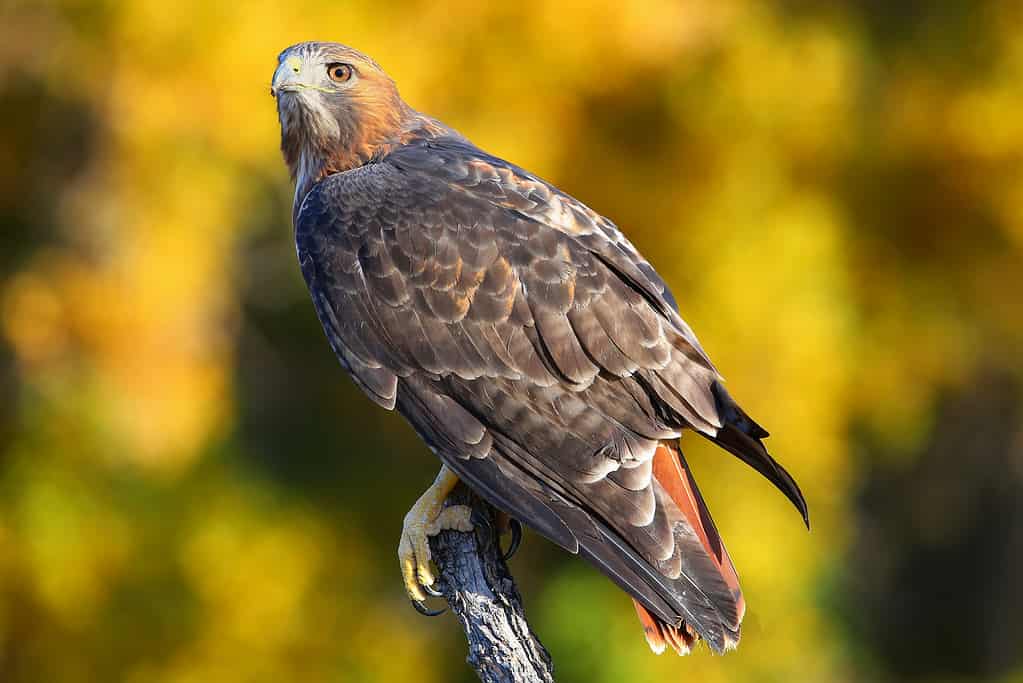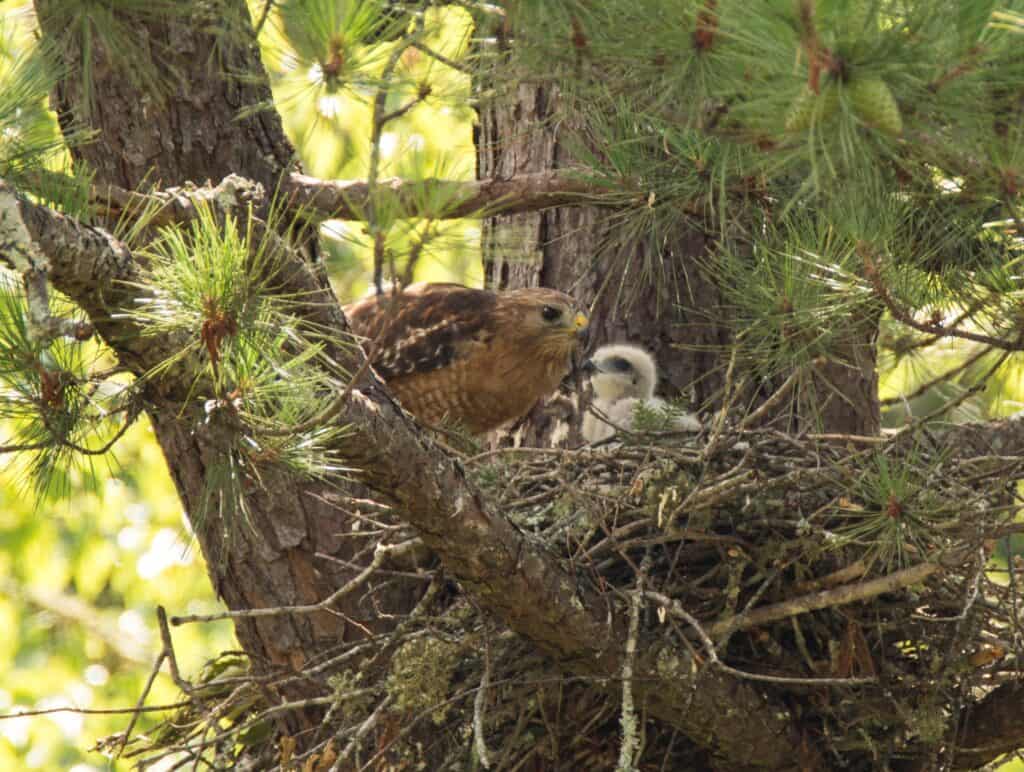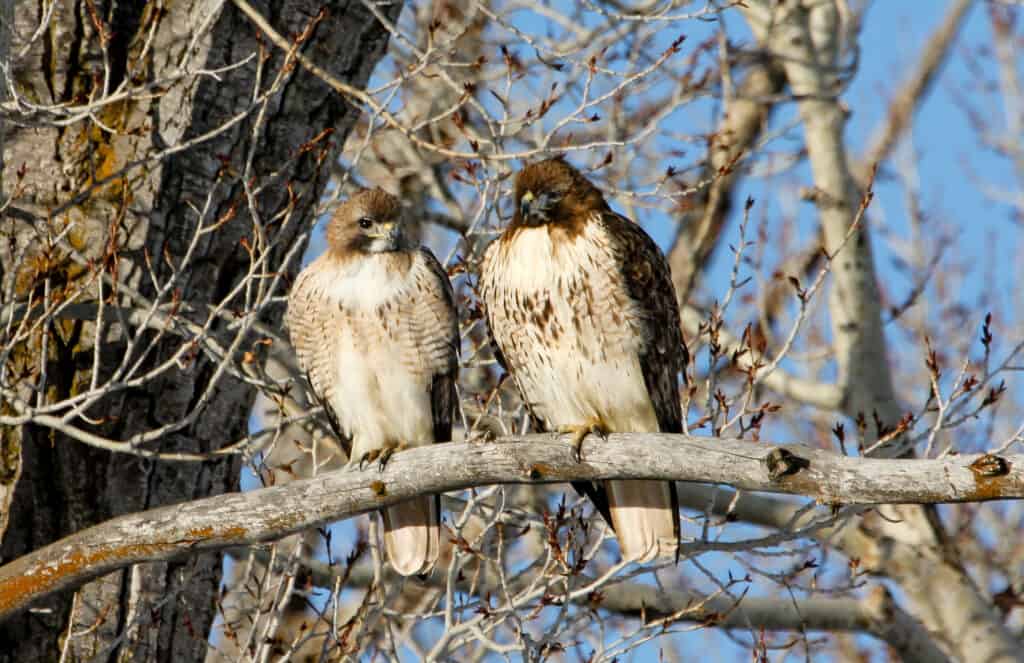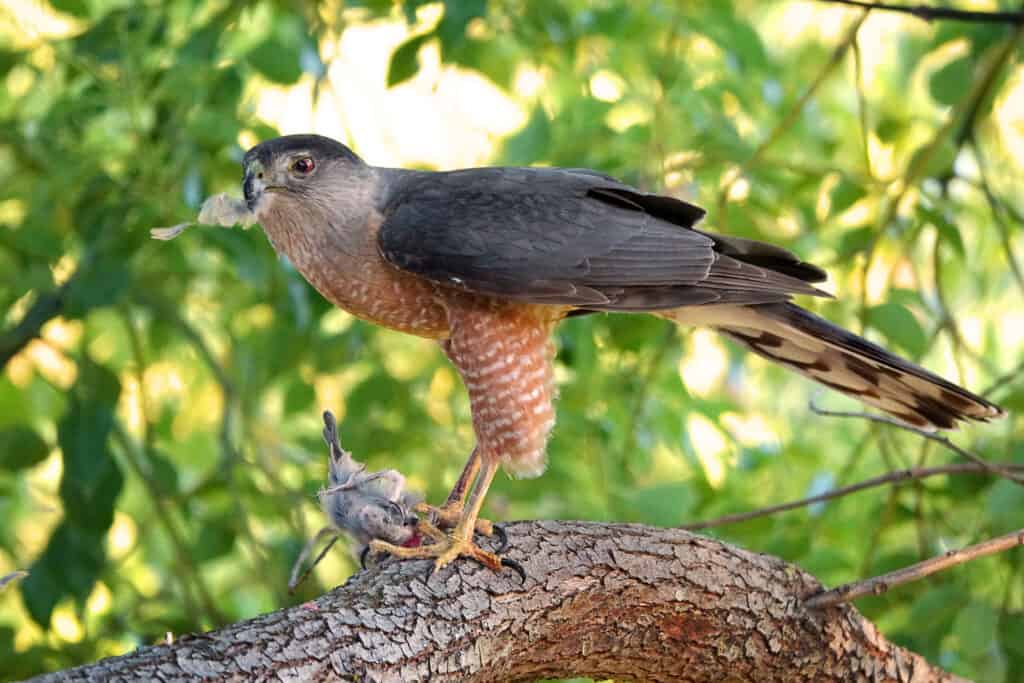Hawks are majestic birds often seen soaring overhead. With over 240 species worldwide, they are widely distributed and are found on every continent except Antarctica. Hawk species vary in habitat, size, and even diet, so it’s no surprise their lifespans vary as well. Here, we take a look at how long hawks live, and what their life cycle looks like.
Background on Hawks

The red-tailed hawk (
Buteo jamaicensis) is the most common hawk in North America.
©iStock.com/Donyanedomam
Hawks are diurnal, meaning that they are active during the day. These predators are top of the daytime food chain. While diets vary by species, hawks generally eat small mammals, fish, reptiles, or amphibians. Their place in the ecosystem is counterpart to the nocturnal owl, which fills the same niche in the food chain.
Hawks track prey with their excellent sense of hearing and eyesight, and their vision is believed to be the best in the world. In fact, a hawk’s eyesight is so good that their visual acuity is around eight times better than that of humans. They have binocular vision and can clearly see objects that are 100 feet from them. Scientists have reported that some raptors can even spot larger prey from up to a mile away.
Hawks are also excellent flyers, able to soar thousands of feet in the air and dive at speeds of up to 150 miles per hour. While migrating hawks will fly higher than 3,000 feet, most hawks prefer to stay 100-300 feet off the ground so that they can scout for prey. These predators are incredibly strong and seize their prey with sharp, curved talons designed for grabbing and gripping. Once an animal is in their strong grasp, it’s nearly impossible to escape. Red-tailed hawks have a grip strength of about 200 pounds per square inch and can carry up to two pounds.
How Long Do Hawks Live?

Red-shouldered hawks (
Buteo lineatus) typically nest around river valleys or lowland forests.
©Patricia Kuhn/Shutterstock.com
While lifespans vary by species, the average lifespan of a hawk in the wild is around 12 years. However, across all species, many birds in the wild do not survive past the first year. For example, only 50% of red-shouldered hawks make it to their first birthday, and even fewer make it to 10 years old.
Lifespan is heavily affected by the environmental threats that each species faces. Hawks can fall prey to natural threats like predators or starvation, as well as man-made dangers such as collisions with automobiles and structures, poisoning, and power lines. While adult hawks do not face many predatorial threats, eggs and younger hawks are vulnerable to predation from raccoons, coyotes, owls, foxes, snakes, and even other hawks.
In captivity, hawks do not face the same threats as in the wild. Thanks to a lack of threats and good medical care, hawks in captivity can live for 20 years or more.
The Typical Hawk Life Cycle

Red-tailed hawks are solitary but will live together during mating season and when raising young.
©Ronnie Howard/Shutterstock.com
Each species has its own unique life cycle, but most follow the same patterns. Clutch sizes vary by species, but females generally lay one to five eggs per mating season, which takes place in the spring. Larger hawks usually lay fewer eggs than smaller species. For example, sharp-shinned hawks have an average weight of 2.9-7.7 ounces and lay four to five eggs per clutch. In comparison, red-tailed hawks weigh 1.5-3.5 pounds and average one to three eggs.
Hatchlings and Nestlings
While hawks are solitary throughout most of the year, mated pairs work together to build nests. They then live together and co-parent their young until the babies (called eyas) are independent. Incubation, like egg count, varies by species but generally falls between 28-48 days. Eyas are altricial when they hatch, meaning they are blind, featherless (but covered with down), and helpless. Altricial birds remain in the nest and rely on their parents for protection, heat, and food. The parents take turns hunting to bring food back to the eyas.
Fledglings
Young hawks stay in the nest until they reach the fledgling stage, which takes place on average at 42-50 days. At this stage, the hawk has its adult feathers, can grip and perch, and is ready to leave the nest. However, it cannot yet fly.
During the fledgling stage, the young leave the nest for the first time. As they explore outside the nest and strengthen their wing muscles, the parents continue to feed them. It can take up to two weeks for these young birds to finish developing and achieve strong flight. During this time, they may remain on the ground, hopping around, trying out their wings, and learning survival skills.
While most hawks strike out on their own two to four weeks after fledging, some stay with their parents for up to 10 weeks. Young hawks, like all other birds in the fledgling stage, are particularly vulnerable to predation threats during this period of their lives.
Maturity
Hawks reach sexual maturity at 18-36 months depending on the species. Red-tailed hawks are considered sexually mature in their third winter (when they are around 2.5 years old). A clear indicator of maturity in this species is the red tail. Red-tailed hawks only develop this distinctive feature when they reach this stage. Cooper’s hawks can begin breeding in their second year, and red-shouldered hawks reach maturity at one to two years.
Lifespan of Different Species

Cooper’s hawk
s often catch prey midair and regularly eat songbirds.
©iStock.com/Linda Koski
When it comes to lifespan, larger hawks usually live longer than small ones. The large red-tailed hawks are the longest-living and have been recorded living over 30 years in the wild. The oldest recorded red-tailed hawk was banded in Michigan in 1981 — and was found again in the same state in 2011 at the age of (at least) 30 years and 8 months.
The smaller Cooper’s hawk (which weighs around 1.2 pounds) has an average lifespan of 12 years in the wild but can live over 20 years. In 2006, a Cooper’s hawk was found in Washington that had been banded in California in 1986, making it at least 20 years and four months old. A Swainson’s hawk banded in California the same year was caught again in 2012 at the ripe old age of 26. While the exact lifespan varies by species, once a hawk of any species makes it to adulthood, they have a possibility of living over two decades.
Check out the different average ages of North American hawks in the chart below.
Lifespan of 7 North American Hawk Species
| Species | Average Lifespan | Oldest Hawk Recorded in the Wild |
|---|---|---|
| Red-tailed hawk | 10-12 years in the wild, 20-25 years in captivity | 30 years, 8 months |
| Cooper’s hawk | 8-10 years in the wild, up to 25 years in captivity | 20 years, 4 months |
| Red-shouldered hawk | 5-10 years in the wild, 20-25 years in captivity | 25 years, 10 months |
| Rough-legged hawk | 5-10 years in the wild, up to 25 years in captivity | 17 years, 9 months |
| Broad-winged hawk | 10-12 years in the wild, 18-20 years in captivity | 18 years, 4 months |
| Northern goshawk | 6-8 years in the wild, 15-20 years in captivity | 17 years, 7 months |
| Swainson’s hawk | 16-20 years in the wild, 20+ years in captivity | 26 years, 1 month |
| Ferruginous hawk | 12-20 years in the wild, 20-30 years in captivity | 23 years, 8 months |
The photo featured at the top of this post is © Brenda Carson/Shutterstock.com
Thank you for reading! Have some feedback for us? Contact the AZ Animals editorial team.







